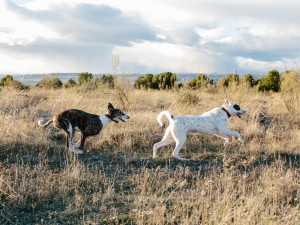Understanding Hemangiosarcoma in Dogs: Blood Vessel Cancer in Dogs
A common canine cancer, described

Share Article
There are a lot of conditions that can bring a pet parent to the vet, but cancer is the worst. The best thing for everyone — dog, vet, and pet parent — is a little preparation. Knowing what you should be looking out for in your dog will make it easier to make a decision when it comes to recognizing an emergency. That means a better outcome for your dog even in difficult circumstances.
Hemangiosarcoma in dogs is a form of cancer that gives very few warnings. These fragile, blood-filled tumors are often not discovered until they rupture. At that point, emergency surgery is the only treatment option, so don’t delay and learn what to expect below.
What is hemangiosarcoma?
Hemangiosarcoma is one of the five most common types of canine cancer, including mast cell tumors, canine melanoma, canine lymphoma, and osteosarcoma. Hemangiosarcoma tumors develop from cells lining the blood vessels.
Since the body is laced with blood vessels, a hemangiosarcoma can appear anywhere. However, they are found about 50 percent of the time in the spleen. The next most common spot is the liver, then the heart. Very rarely, they’re on the skin. This form of cancer is quite aggressive cancer and is most commonly found in middle-aged to older dogs, and slightly more often in males. It’s not clear why dogs develop this form of cancer, but when they’re found on or under the skin, there is sometimes a correlation to sun exposure on thinly-haired spots, like the belly, inner thighs, and eyelids. So your dog might need some shade, too.

Are certain breeds predisposed to hemangiosarcoma?
Golden Retrievers, German Shepherdsopens in new tab, Portuguese Water Dogs, Boxers and Skye Terriersopens in new tab are the most commonly affected breeds by hemangiosarcoma cancer, so if you are the owner of one of those breeds, stay especially aware of their energy levels and skin. Vigilance is the best support for your dog friend.
Signs and symptoms of hemangiosarcoma.
As stated above, it is hard to detect these tumors, but there are definitely some signs to be vigilant about. A tumor on or under the skin will often look like a dark red or purple bump that may bruise or bleed. For internal tumors, early signs may be as subtle as lethargy and pale gums.
A hemangiosarcoma develops slowly to start, but as it grows, the blood vessels supporting it begin to leak, resulting in blood loss into the abdomen. That’s when symptoms become more pronounced: weight loss, decreased appetite, increased panting, weakness, cough, or a bulging belly. If your dog is suddenly weak and has a swollen or pendulous abdomen or pale gums, it may be caused by their spleen rupturing and hemorrhaging.
How is hemangiosarcoma diagnosed?
When you see a suspicious skin mass, meaning one that’s larger than a pea or which has been lingering for over a month, get it checked out. A vet will perform a fine needle aspiration to procure a sample. But when an internal tumor is suspected, this method is much trickier. Instead, diagnosis usually involves bloodwork, an abdominal ultrasound, X-rays, and a CT scan.
How is hemangiosarcoma treated?
Surgery and chemotherapy are the most common treatments, although a hemangiosarcoma is likely to have metastasized by the time it’s diagnosed. A possible exception is a hemangiosarcoma in or under the skin, because the pet parent is much more likely to notice it early. The principal goal of treatment is to slow down or delay the spread of the tumor and prevent life-threatening bleeding episodes. Currently, the prospect of a cure, or even a remission, is extremely unlikely for a dog suffering from hemangiosarcoma.
When a hemangiosarcoma ruptures.
A spleen mass that ruptures requires surgery to remove the spleen. While the surgery can be life-saving, if the mass is a hemangiosarcoma, it will have already metastasized microscopically. However, not all spleen masses are cancer — approximately 50 percent of bleeding masses on the spleen may be benign. Vets may recommend a splenectomy and pathologic evaluation of the spleen, though it may only give the dog a few more months of quality life if the mass turns out to be a hemangiosarcoma. Within three to four months, the dog will have multiple tumors throughout the lungs and other parts of the body.
Advanced treatments for hemangiosarcoma.
A 2012 study undertaken at the University of Pennsylvania reported success with an extract of a medicinal mushroom, Coriolus versicolor, in extending the lives of 15 Golden Retrievers with hemangiosarcoma. The mushroom contains a compound called polysaccharopeptide, or PSP, which some studies have suggested has both immune-boosting properties and a tumor-fighting effect. It has no side effects and is relatively inexpensive. However, to date — probably due to a lack of research — it’s rarely suggested or used by veterinary oncologists.
Currently, it’s estimated that a dog who tests negative for hemangiosarcoma has a less than 1 percent likelihood of developing it over a six-month period, while more than 90 percent of dogs with a positive test require further evaluation.
Dogs at high risk are eligible to receive eBAT, a genetically engineered drug developed at the university in 2017, as a preventive. According to the drug’s creator, Daniel A. Vallera, PhD, “eBAT was created to specifically target tumors while causing minimal damage to the immune system. … [It] was selected for this trial because it can simultaneously target the tumor and its vascular system.”
In other words, it kills emerging cancer cells and inhibits the environment they need to grow. Findings to date indicate that not only can the novel blood test accurately indicate the presence of hemangiosarcoma in otherwise healthy dogs with a 90 percent accuracy rate, it can also predict when treatment fails and the disease comes back.
Susan Tasaki
Freelance writer Susan Tasaki lives in the San Francisco Bay Area with her Husky, who wishes they both got out more.
Related articles
![dog owner sad and comforting fluffy dog]()
How to Navigate Tough Decisions About Your Pet
Lessons on how to cope with a serious health diagnosis.
![Dalmatian mix breed dog is playing with a dog toy on a soft surface]()
Digging into the Fine Print of Pet Insurance
Everything you need to know to understand pet insurance plans.
![Closeup of white lab mix dog being pet under the chin by pet parent]()
Can Dogs Get Breast Cancer?
Sadly, yes — one in four dogs will develop mammary tumors — but there's an easy way to prevent them.
![Two dog chasing each other playfully in a prairie field outside]()
Don’t Worry, But Dogs Can Get Cancer From Sniffing Other Dogs’ Nether-Regions
The gnarly scoop on canine transmissible venereal tumors.





